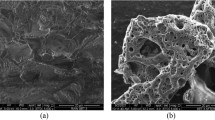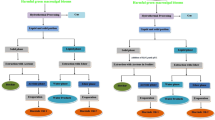Abstract
Spent bleaching clay (SBC) containing ~33 wt% adsorbed residual oil from the refining of palm oil in the milling industry was evaluated for use as a sole carbon source for poly(3-hydroxybutyrate-co-3-hydroxyhexanoate) [P(3HB-co-3HHx)] production by the recombinant strain Cupriavidus necator Re2058/pCB113. The biosynthesis of polyhydroxyalkanoate (PHA) was conducted in a one-stage cultivation process using shaken flasks. Palm olein and the extracted oil from SBC were used for comparison with the adsorbed residual oil (ARO) in SBC to evaluate the efficiency of the latter as a carbon source. The ARO in SBC can be utilized by the bacterium for the growth and accumulation of PHA. Cell growth and PHA accumulation were observed to be the best when 20 g/L ARO was supplied as a carbon source, resulting in the production of 11.8 g/L dry cell weight containing 39.8 wt% P(3HB-co-15 mol% 3HHx). The biomass yield showed that ARO in SBC is a suitable carbon feedstock for this strain. Thus, these results suggest that ARO in SBC, an inexpensive carbon source, can be used to produce low-cost commercialized PHA in bulk.
This is a preview of subscription content, access via your institution
Access options
Subscribe to this journal
Receive 12 print issues and online access
$259.00 per year
only $21.58 per issue
Buy this article
- Purchase on Springer Link
- Instant access to full article PDF
Prices may be subject to local taxes which are calculated during checkout






Similar content being viewed by others
References
Riedel SL, Bader J, Brigham CJ, Budde CF, Yusof ZAM, Rha C, et al. Production of poly(3-hydroxybutyrate-co-3-hydroxyhexanoate) by Ralstonia eutropha in high cell density palm oil fermentations. Biotechnol Bioeng. 2012;109:74–83.
Salgaonkar BB, Mani K, Bragança JM. Accumulation of polyhydroxyalkanoates by halophilic archaea isolated from traditional solar salterns of India. Extremophiles. 2013;17:787–95.
Hempel F, Bozarth AS, Lindenkamp N, Klingl A, Zauner S, Linne U, et al. Microalgae as bioreactors for bioplastic production. Microb Cell Fact. 2011;10:81.
Koller M, Braunegg G. Advanced approaches to produce polyhydroxyalkanoate (PHA) biopolyesters in a sustainable and economic fashion. Eurobiotech J. 2018;2:89–103.
Sridewi N, Bhubalan K, Sudesh K. Degradation of commercially important polyhydroxyalkanoates in tropical mangrove ecosystem. Polym Degrad Stab. 2006;91:2931–40.
Muhr A, Rechberger EM, Salerno A, Reiterer A, Schiller M, Kwiecień M, et al. Biodegradable latexes from animal-derived waste: Biosynthesis and characterization of mcl-PHA accumulated by Ps. citronellolis. React Funct Polym. 2013;73:1391–8.
Ciesielski S, Możejko J, Pisutpaisal N. Plant oils as promising substrates for polyhydroxyalkanoates production. J Clean Prod. 2015;106:408–21.
Hazer B, Torul O, Borcakli M, Lenz RW, Fuller RC, Goodwin SD. Bacterial production of polyesters from free fatty acids obtained from natural oils by Pseudomonas oleovorans. J Environ Polym Degrad. 1998;6:109–13.
Ng K-S, Wong Y-M, Tsuge T, Sudesh K. Biosynthesis and characterization of poly(3-hydroxybutyrate-co-3-hydroxyvalerate) and poly(3-hydroxybutyrate-co-3-hydroxyhexanoate) copolymers using jatropha oil as the main carbon source. Process Biochem. 2011;46:1572–8.
Bhatia SK, Kim J-H, Kim M-S, Kim J, Hong JW, Hong YG, et al. Production of (3-hydroxybutyrate-co-3-hydroxyhexanoate) copolymer from coffee waste oil using engineered Ralstonia eutropha. Bioproc Biosyst Eng. 2018;41:229–35.
Song JH, Jeon CO, Choi MH, Yoon SC, Park W. Polyhydroxyalkanoate (PHA) production using waste vegetable oil by Pseudomonas sp. strain DR2. J Microbiol Biotechnol. 2008;18:1408–15.
Riedel SL, Jahns S, Koenig S, Bock MC, Brigham CJ, Bader J, et al. Polyhydroxyalkanoates production with Ralstonia eutropha from low quality waste animal fats. J Biotechnol. 2015;214:119–27.
Thinagaran L, Sudesh K. Evaluation of sludge palm oil as feedstock and development of efficient method for its utilization to produce polyhydroxyalkanoate. Waste Biomass Valorization. 2019;10:709–20.
Nambiappan B, Ismail A, Hashim N, Ismail N, Nazrima S, Idris NAN, et al. Malaysia: 100 years of resilient palm oil economic performance. J Oil Palm Res. 2018;30:13–25.
Khatun R, Reza MIH, Moniruzzaman M, Yaakob Z. Sustainable oil palm industry: The possibilities. Renew Sust Energy Rev. 2017;76:608–19.
MPOB. http://bepi.mpob.gov.my/index.php/en/statistics/sectoral-status/190-sectoral-status-2018/864-number-a-capacities-of-palm-oil-sectors-2018.html. 2018. Accessed 28 Aug 2019.
Egbuna S. Development of kinetic model for adsorption of carotenoids on activated clay in the bleaching of palm oil. Int J Res Eng Technol. 2014;3:3.
Beshara A, Cheeseman CR. Reuse of spent bleaching earth by polymerisation of residual organics. J Waste Manag. 2014;34:1770–4.
Aziz MKA, Okayama T, Kose R, Morad NA, Muhamad NBN, Mansor MRB, et al. Green extraction process for oil recovery using bioethanol. In: Green technologies for the oil palm industry; Springer, Singapore, 2019. p. 57–70.
Eliche-Quesada D. Reusing of oil industry waste as secondary material in clay bricks. J Miner. 2015;1:29–39.
Merikhy A, Heydari A, Eskandari H, Nematollahzadeh A. Revalorization of spent bleaching earth a waste from vegetable oil refinery plant by an efficient solvent extraction system. Waste Biomass Valorization. 2018;10:1–11.
Budde CF, Riedel SL, Willis LB, Rha C, Sinskey AJ. Production of poly(3-hydroxybutyrate-co-3-hydroxyhexanoate) from plant oil by engineered Ralstonia eutropha strains. Appl Environ Microbiol. 2011;77:2847–54.
Doi Y, Kitamura S, Abe H. Microbial synthesis and characterization of poly(3-hydroxybutyrate-co-3-hydroxyhexanoate). Macromolecules. 1995;28:4822–8.
Budde CF, Mahan AE, Lu J, Rha C, Sinskey AJ. Roles of multiple acetoacetyl coenzyme A reductases in polyhydroxybutyrate biosynthesis in Ralstonia eutropha H16. J Bacteriol. 2010;192:5319–28.
Braunegg G, Sonnleitner B, Lafferty R. A rapid gas chromatographic method for the determination of poly-β-hydroxybutyric acid in microbial biomass. Appl Microbiol Biotechnol. 1978;6:29–37.
Pereira MG, Hamerski F, Andrade EF, Scheer AdP, Corazza ML. Assessment of subcritical propane, ultrasound-assisted and soxhlet extraction of oil from sweet passion fruit (Passiflora alata curtis) seeds. J Supercrit Fluids. 2017;128:338–48.
Bachmann SAL, Valle RdCSC, Vegini AA and Tavares LBB. Determination of optimum condition for thermal regeneration and characterization of a spent bleaching earth. J Environ Chem Eng. 2019;8:103503.
Ming H, Pizarro AVL, Park EY. Application of waste activated bleaching earth containing rapeseed oil on riboflavin production in the culture of Ashbya gossypii. Biotechnol Prog. 2003;19:410–7.
Loh SK, Cheong KY, Salimon J. Surface-active physicochemical characteristics of spent bleaching earth on soil-plant interaction and water-nutrient uptake: A review. Appl Clay Sci. 2017;140:59–65.
Tippkötter N, Wollny S, Suck K, Sohling U, Ruf F, Ulber R. Recycling of spent oil bleaching earth as source of glycerol for the anaerobic production of acetone, butanol, and ethanol with Clostridium diolis and lipolytic Clostridium lundense. Eng Life Sci. 2014;14:425–32.
Nursulihatimarsyila A, Cheah K, Chuah T, Siew W, Choong T. Deoiling and regeneration efficiencies of spent bleaching clay. Am J Appl Sci. 2010;7:434–7.
Melero JA, Bautista LF, Morales G, Iglesias J, Sánchez-Vázquez R. Biodiesel production from crude palm oil using sulfonic acid-modified mesostructured catalysts. Chem Eng. 2010;161:323–31.
Kheang LS, Foon CS, May CY, Ngan MA. A study of residual oils recovered from spent bleaching earth: Their characteristics and applications. Am J Appl Sci. 2006;3:2063–7.
Kahar P, Tsuge T, Taguchi K, Doi Y. High yield production of polyhydroxyalkanoates from soybean oil by Ralstonia eutropha and its recombinant strain. Polym Degrad Stab. 2004;83:79–86.
Boey P-L, Saleh MI, Sapawe N, Ganesan S, Maniam GP, Ali DMH. Pyrolysis of residual palm oil in spent bleaching clay by modified tubular furnace and analysis of the products by GC–MS. J Anal Appl Pyrolysis. 2011;91:199–204.
Mana M, Ouali M-S, De Menorval L-C. Removal of basic dyes from aqueous solutions with a treated spent bleaching earth. J Colloid Interface Sci. 2007;307:9–16.
Akiyama M, Tsuge T, Doi Y. Environmental life cycle comparison of polyhydroxyalkanoates produced from renewable carbon resources by bacterial fermentation. Polym Degrad Stab. 2003;80:183–94.
Murugan P, Gan C-Y, Sudesh K. Biosynthesis of P(3HB-co-3HHx) with improved molecular weights from a mixture of palm olein and fructose by Cupriavidus necator Re2058/pCB113. Int J Biol Macromol. 2017;102:1112–9.
Avila-Orta CA, Medellı́n-Rodrı́guez FJ, Wang Z-G, Navarro-Rodrı́guez D, Hsiao BS, Yeh F. On the nature of multiple melting in poly(ethylene terephthalate)(PET) and its copolymers with cyclohexylene dimethylene terephthalate (PET/CT). Polymer. 2003;44:1527–35.
Nayak R, Kyratzis IL, Truong YB, Padhye R, Arnold L. Melt-electrospinning of polypropylene with conductive additives. J Mater Sci. 2012;47:6387–96.
Volova TG, Syrvacheva DA, Zhila NO, Sukovatiy AG. Synthesis of P (3HB-co-3HHx) copolymers containing high molar fraction of 3-hydroxyhexanoate monomer by Cupriavidus eutrophus B10646. J Chem Technol Biotechnol. 2016;91:416–25.
Watanabe T, He Y, Fukuchi T, Inoue Y. Comonomer compositional distribution and thermal characteristics of bacterially synthesized poly(3-hydroxybutyrate-co-3-hydroxyhexanoate)s. Macromol Biosci. 2001;1:75–83.
Murugan P, Han L, Gan C-Y, Maurer FH, Sudesh K. A new biological recovery approach for PHA using mealworm, Tenebrio molitor. J Biotechnol. 2016;239:98–105.
Ramkumar D, Bhattacharya M. Steady shear and dynamic properties of biodegradable polyesters. Polym Eng Sci. 1998;38:1426–35.
Verhoogt H, Ramsay BA, Favis BD, Ramsay JA. The influence of thermal history on the properties of poly(3-hydroxybutyrate-co-12%-3-hydroxyvalerate). J Appl Polym Sci. 1996;61:87–96.
Acknowledgements
The C. necator Re2058/pCB113 strain used in this study was kindly provided by Prof. Anthony Sinskey of MIT. This study was supported by a grant from the Ministry of Education of Malaysia (203/PBIOLOGI/67811001) titled “Soil Analysis and Value-Addition to Oil Palm Trunk (OPT) and Sap Through Biotechnology,” as well as the Science and Technology Research Partnership for Sustainable Development (SATREPS). NHMH thanks the graduate assistant scheme provided by Universiti Sains Malaysia for financial support. The authors would also like to thank KL-Kepong Oleomas Sdn. Bhd. for supplying SBC and Dr. Chuah Jo-Ann for English editing.
Author information
Authors and Affiliations
Corresponding author
Ethics declarations
Conflict of interest
The authors declare that they have no conflict of interest.
Additional information
Publisher’s note Springer Nature remains neutral with regard to jurisdictional claims in published maps and institutional affiliations.
Rights and permissions
About this article
Cite this article
Hairudin, N.H.B.M., Ganesan, S. & Sudesh, K. Revalorization of adsorbed residual oil in spent bleaching clay as a sole carbon source for polyhydroxyalkanoate (PHA) accumulation in Cupriavidus necator Re2058/pCB113. Polym J 53, 169–178 (2021). https://doi.org/10.1038/s41428-020-00418-2
Received:
Revised:
Accepted:
Published:
Issue Date:
DOI: https://doi.org/10.1038/s41428-020-00418-2
This article is cited by
-
Polyhydroxyalkanoates: a review of microbial production and technology application
International Journal of Environmental Science and Technology (2023)
-
Special issue: CO2: capture of, utilization of, and degradation into
Polymer Journal (2021)
-
Established and Emerging Producers of PHA: Redefining the Possibility
Applied Biochemistry and Biotechnology (2021)



